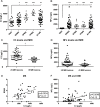Complement component C3 and butyrylcholinesterase activity are associated with neurodegeneration and clinical disability in multiple sclerosis
- PMID: 25835709
- PMCID: PMC4383591
- DOI: 10.1371/journal.pone.0122048
Complement component C3 and butyrylcholinesterase activity are associated with neurodegeneration and clinical disability in multiple sclerosis
Abstract
Dysregulation of the complement system is evident in many CNS diseases but mechanisms regulating complement activation in the CNS remain unclear. In a recent large rat genome-wide expression profiling and linkage analysis we found co-regulation of complement C3 immediately downstream of butyrylcholinesterase (BuChE), an enzyme hydrolyzing acetylcholine (ACh), a classical neurotransmitter with immunoregulatory effects. We here determined levels of neurofilament-light (NFL), a marker for ongoing nerve injury, C3 and activity of the two main ACh hydrolyzing enzymes, acetylcholinesterase (AChE) and BuChE, in cerebrospinal fluid (CSF) from patients with MS (n = 48) and non-inflammatory controls (n = 18). C3 levels were elevated in MS patients compared to controls and correlated both to disability and NFL. C3 levels were not induced by relapses, but were increased in patients with ≥9 cerebral lesions on magnetic resonance imaging and in patients with progressive disease. BuChE activity did not differ at the group level, but was correlated to both C3 and NFL levels in individual samples. In conclusion, we show that CSF C3 correlates both to a marker for ongoing nerve injury and degree of disease disability. Moreover, our results also suggest a potential link between intrathecal cholinergic activity and complement activation. These results motivate further efforts directed at elucidating the regulation and effector functions of the complement system in MS, and its relation to cholinergic tone.
Conflict of interest statement
Figures



References
MeSH terms
Substances
LinkOut - more resources
Full Text Sources
Other Literature Sources
Medical
Miscellaneous

